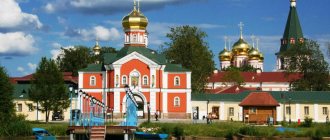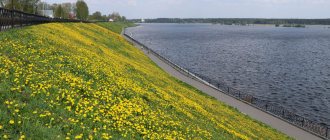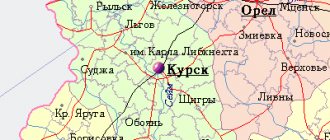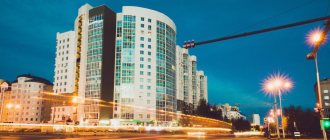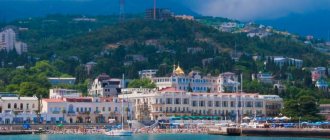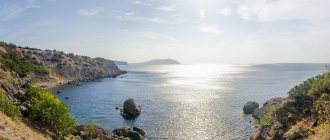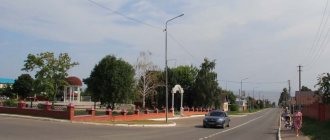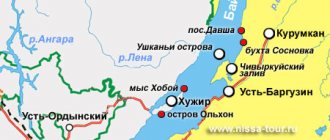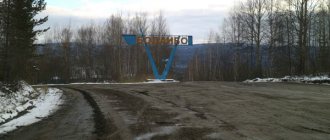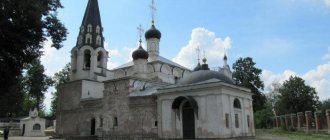General information and brief history of Bakhchisarai
Bakhchisaray is a small town in Crimea, located between the major Crimean cities of Simferopol and Sevastopol. It occupies a favorable economic position and is connected with the capital of Crimea by rail and road routes.
Panoramic view of the city
1532 is considered the year of foundation of the capital of the Crimean Khanate, Bakhchisarai. “The blooming garden is the palace of gardens,” as Khan Mengli-Girey colorfully called it. The construction of the residence of the Crimean khans was completed in 1551. Houses began to appear around the palace, where small traders and artisans lived, and the Khan's palace itself was located on the Churuk-Su river between two ridges of the Crimean mountains.
A city with a rich history and culture, which, despite historical conflicts, was able to preserve its identity. Even before the emergence of the Golden Horde and the seizure of territories by warring tribes, Karaites and Christians lived peacefully on the lands of Crimea. In 754, Greek monks appeared here, and Orthodoxy developed. In the 15th century The Assumption Monastery is called the center of Orthodoxy in Crimea - the Crimean Athos.
Wars and peaceful life, cultural development - all this was present at the long historical stage of the development and formation of the city of Bakhchisarai. The Soviet period begins in 1918 and is marked by industrial growth and development, it was at this time that large enterprises and factories appeared.
View of the city at night
Such famous personalities as A.V. Suvorov, G.A. Potemkin, the Iranian architect and sculptor Omer, who created the Fountain of Tears from marble, contributed to the history of the city. The city was sung in works of art by A. S. Pushkin, Adam Mickiewicz, Lesya Ukrainka, A. P. Chekhov, L. N. Tolstoy. V. A. Serov immortalized the city on his canvases. Many other famous people admired the history of the region.
Where to go with your child?
A child will be truly delighted by a visit to the “Crimea in Miniature” park, where you can admire the main attractions of the peninsula, made on a scale of 1:25. Among the exhibits there are copies of the famous Swallow's Nest, Massandra and Vorontsov palaces. There is also a wonderful “Fairy Tale Park” with many sculptures of cartoon characters. Colorful photos as a souvenir are guaranteed.
It’s easy to have fun with your family at the Miracle Donkey Farm. Today, donkeys of the endangered Nubian and Somali breeds are bred here. After visiting the unique Donkey Museum, you can taste the milk of these animals. There is a small zoo on site where you can watch ostriches, peacocks and horses. The adventure will be completed by a short trip on donkeys around the outskirts of Bakhchisarai; your vacation in Crimea will definitely be memorable! There is that and another similar farm - “Ishachok”.
Climatic conditions and environmental conditions
The climate in Bakhchisarai is temperate continental. In addition to gardens and plantations with medicinal herbs, the city is surrounded by coniferous and deciduous forests, which at one time were planted specifically to improve the environmental situation in the area.
Winters are rarely cold. Lately, nature has been presenting incidents: it may snow in April, but it will definitely rain on New Year’s Day. The weather, like a capricious Crimean woman, changes throughout the day. Usually it is quiet in the morning and evening, and the wind blows during the day. In winter it is nasty and cold, and in summer it is sweltering and hot, bringing no relief. Temperature minimums in winter down to −10 °C occur once every 3-5 years.
Abnormally fallen snow in April, when fruit trees were blooming, 2012.
The hottest months in summer are July and August. Summer maximum up to +40 °C. Warm until mid-October. This “Indian summer” pleases not only local residents, but also lovers of a relaxing holiday at sea.
As for the environment, the Bakhchisarai cement plant causes irreparable harm to the health of city residents. Despite assurances about control over the emission of harmful processing products into the atmosphere and the modernization of treatment plants, management cannot provide the population of the city and surrounding areas with an objective supply of information. It is enough to drive to the territory of the plant to see for yourself what the area looks like: all the trees, asphalt, and buildings are covered with a thick layer of white-gray dust. It spreads throughout the city, ending up in the water, gardens and fields. The city has a high level of morbidity of the respiratory system of an allergic nature.
Within the city, at the exit towards Sevastopol, there is the Bakhchisaray reservoir. This is a man-made artificial reservoir. Water comes here from the Kacha River. The area of the reservoir is about 110 hectares. This place is a favorite for fishermen and ordinary locals who want to relax in nature, barbecue and swim on a hot summer day. But it’s precisely with bathing that problems arise. Officially, the reservoir is closed by the SES, as indicated by the corresponding inscription, but this stops few people. Several years ago there was an accident, as a result of which a fisherman died from the infectious disease leptospirosis, just after staying at the Bakhchisarai reservoir. The doctors did not immediately understand what they were dealing with; the man could not be saved.
Bakhchisarai Reservoir
Thanks to the “efforts” of local residents, the famous Churuk-Su river in the old part of the city began to bear the derogatory name “Stinky River.” Garbage is dumped here, since there is no centralized sewage system, and toilets with pit cesspools are built in vegetable gardens. Therefore, all the runoff seeps into a small river.
The headache of local residents is the garbage cans that are located in the residential area and are a source of foul odor in the summer. The state utility company cannot cope with garbage removal, and after local residents of the 6th microdistrict, living next to the landfill, went on strike, there was nowhere to take out the garbage. Now it is transported outside the city by agreement to the landfill of the Pochtovsky Village Council.
Population of Bakhchisarai
According to the latest statistics, the city's population is 27 thousand people.
If we consider which nationality is more represented in quantitative terms, we get the following picture:
- 49% Russians;
- 25% Crimean Tatars;
- 23% Ukrainians;
- 3% - other nationalities: Jews, Karaites, Belarusians, Germans, Greeks, Bulgarians, Armenians, Chechens, Moldovans, Gypsies, etc.
City population at the festival
After the collapse of the USSR, the demographic situation left much to be desired. If anyone has not slowed down the birth rate, despite the crisis and the almost complete lack of cash payments, it is the Crimean Tatars. Their task was to fill Crimea with representatives of their nationality as quickly as possible after returning from deportation. As can be seen from the statistics, they succeeded.
As for the jump in the birth rate in the last 2-3 years, this is largely due to the laws adopted by the Ukrainian government. Payments for the birth of children were increased. The benefit for the 3rd child is $11,538, spread over 6 years. A family with 3 children was considered to have many children. Benefits: 50% payment for utilities, first in line for free trips to sanatoriums, free travel on public transport. State reforms to provide for families with children had a positive tendency to increase the birth rate.
If we talk about migration processes, then in Bakhchisarai, due to certain difficulties in getting a job, many men and women of working age leave for Russia, Europe and Turkey. Crimean Tatars are looking for employment options in Turkey. The work is no different from that of the Slavs in Europe: caring for children and elderly people with disabilities. Therefore, a significant part of the working-age population is outside the city, and the majority of residents are pensioners and young mothers with children.
People of retirement age who previously lived in Simferopol, Sevastopol and the northern regions of Russia are buying apartments and houses in Bakhchisarai, as the city is quiet and peaceful.
Over the past ten years, a friendly atmosphere has developed in the multinational region.
How to get there
It’s easy to get to Bakhchisarai from any city in Crimea:
- a bus departs from Simferopol from the Zapadnaya bus station every half hour, travel time is 30 minutes;
- from Sevastopol from the bus station, regular buses depart every 20 minutes, travel time is 40 minutes;
- There are also regular buses from Yalta to Bakhchisarai in Crimea, but you will have to spend more time - 3 hours; it will only be faster by private car through Ai-Petri.
If you want to get to Bakhchisarai from mainland Russia by car, then after crossing the Crimean Bridge you just need to drive, without turning, along the Tavrida highway, and after 270 km (a little more than 3 hours of travel) you will be there.
We hope that our article helped you understand where Bakhchisarai is located in Crimea, what you can see here and how to get here. Bakhchisarai is not a popular resort like Yalta or Yevpatoria, but this is its charm. Due to the short distance from the sea, there are few tourists here, which allows you to fully enjoy the indescribable atmosphere and charm of this “garden-palace”. You can safely stay here for a few days in order to have time to explore the city itself and its surroundings without haste, or you can go on an excursion to Bakhchisarai from neighboring cities. If you wish, you can even combine a visit to Bakhchisarai with a beach holiday, especially if you have a car and don’t mind spending about 20 minutes on the road to the sea. In any case, you definitely need to see this city, where else can you find such an amazing Crimean Tatar flavor.
0 0 votes
Article rating
Districts and real estate of Bakhchisarai
Modern Bakhchisarai can be conditionally divided into four parts: the old city, where the Khan’s Palace, the Assumption Monastery, Chufut-Kale are located; a new city, where the main residential area of apartment buildings is located, the railway station area with Kizyakov dachas, and the recently built private sector microdistricts No. 5, 5a, 6, 7.
Old city
The historical and tourist part of the city is the Old Town. In addition to architectural monuments, museums, a cave city, and the recently opened Miniature Park, there are private houses located on the sloping mountains. Most of the houses were built before the war: unsightly ones with low ceilings only spoil the appearance of the city. There is a feeling that life here stopped in the 50s.
Old city. Photo by lazerlazal (https://www.panoramio.com/user/104593)
In this part of the city there is a tourist base “Prival”, the territory of which is quite comfortable for vacationers.
Tourist base "Prival". Photo by Valentina Kuznetsova, Sarov
High in the mountains there are both small houses and a 2-story building, a dining room, bars, an outdoor pool and gazebos for relaxation. All this is next to a juniper grove, the air is intoxicatingly clean, and there is a view of the old part of the city from above.
Among the public institutions in this part of the city there is a registry office, secondary school No. 2 and a kindergarten, and an employment center. School No. 2 is very old, there is not even a toilet for children in the building, it is located on the street.
Previously, the city had a “Start” cinema and an open-air summer cinema. “Start” was given over to a mosque, and a restaurant of oriental cuisine was built on the site of a summer cinema.
The network of small restaurants, cafes, and bars is aimed at tourists. They offer to taste unusual oriental cuisine in an appropriate atmosphere of oriental flavor.
At the exit from the old part of the city, the Druzhba stadium was built, where football matches and festive events take place: concerts, performances by athletes.
The cost of houses in this part of the city starts from 10 thousand dollars.
New town
The new city is divided by the central street Frunze into two parts: residential buildings of the Khrushchev era, the private sector of the same type of resettlement houses and newer apartment buildings of the 80s and 90s.
The administrative building of the district council and district state administration is also located here, which overlooks Lenin Square.
Lenin Square, New Town
From social infrastructure: central district hospital; 4 kindergartens, one of which has a speech therapy focus, the other with Crimean Tatar groups and teaching children their native language; 2 secondary schools and 1 Crimean Tatar school.
Bakhchisarai secondary school No. 3. From the 5th grade, each parallel has a gymnasium class. Tuition is provided as a charity and is $12 per month, plus window fees, school needs, and class needs.
General education school No. 4. In each parallel from 1st grade there is 1st grade with instruction in Ukrainian. There are more Crimean Tatars who want to study in Ukrainian than Slavs.
Crimean Tatars have the opportunity to receive education in their native language in a specialized school. Children under the experience exchange program can go to Turkey. Comfortable conditions have been created for the preservation of national traditions and the cultural development of children.
One of the city’s significant problems is kindergartens. In the 1990s, the birth rate fell sharply. Kindergartens were closed, but when life gradually began to get better, it turned out that there were no places in the kindergartens. There are 35 children in groups, which exceeds the norm. One of the advantages of recent years: kindergartens have their own mini-boiler houses.
Mini boiler house providing heat to 3 kindergartens and 1 school
Residential buildings have fallen into deplorable condition in recent years: the roofs and the buildings themselves require major repairs. In the new area there are a lot of unfinished buildings that have begun to be dismantled and the blocks taken away in an unknown direction.
Houses built during the USSR
Of the modern buildings in the area, only multi-storey buildings from the Mejlis with financial support from Turkey for the Crimean Tatars. They are immediately available for rent with plastic windows and a mini-boiler room for the entire house. Crimean Tatars receive apartments for free.
Houses built with Turkish money for Crimean Tatars
The cost of a 1-room apartment is from 15 thousand dollars, a 2-room apartment is 25 thousand dollars, 2-storey houses with plots of land of 6 acres are from 50 thousand dollars.
The Bakhchisarai district hospital consists of a clinic, maternity hospital, infectious diseases, therapeutic, intensive care, neurological, surgical, traumatological, children's, and gynecological departments.
Bakhchisarai maternity hospital
Microdistricts 5, 5a, 6, 7
Microdistricts 5a, 5, 6, 7 differ somewhat in terms of where people live based on their nationality. The first plots of land were given to city chiefs and officials at various levels, and thus the 5a microdistrict was built. We can say that this is an elite village within the city.
Elite 5 microdistrict
Microdistricts 5 and 6 are mixed in population; beautiful and comfortable houses were built by the people themselves, who received plots of land as their own.
Microdistrict 7 is almost completely populated by Crimean Tatars. Recently they opened buses and minibuses into the neighborhoods, but there are no schools or kindergartens. It is necessary to bring or bring children to the New City.
The cost of houses is from 100 thousand dollars. The cost of a plot starts from $1000 per hundred square meters of land.
Area of the railway station and Kizyakov dachas
Over the course of several years, the railway station was brought into proper shape, and good repairs were made both outside and inside the building. Now there is no shame in meeting tourists. The Bakhchisarai station connects Sevastopol, Simferopol and Evpatoria inside Crimea. Electric trains are a convenient and cheap option for students and working people in other cities. Trains from Moscow, Kyiv, St. Petersburg, heading to Sevastopol, pass through Bakhchisarai.
Train Station. Photo by el-yatsuk (https://fotki.yandex.ru/users/el-yatsuk/)
The area of Kizyakov dachas is more represented by resettlement houses of the private sector.
There are enterprises here: a bakery and a winery.
City infrastructure
In addition to the railway connection, the city has a bus station, from where buses depart throughout Crimea and to nearby cities of continental Ukraine: Dnepropetrovsk, Kherson, Melitopol, Nikolaev, Odessa. The Bakhchisaray district unites towns and villages that are located on the Black Sea coast: Peschanoye village, village. Angular, s. Beregovoe. You can get to the sea either by personal transport or by buses and minibuses. Time from 30 to 60 minutes. The distance is approximately 15-20 km.
Utility companies in the city operate in working mode and ensure timely supply of water, gas, and electrical energy. Prices are regulated at the level of deputies sessionally.
Residents, in order not to overpay for services, install meters for water and gas. The inadequate price during the heating season of about $100 for a 3-room apartment is solved by providing an individual heating system in the apartment, then the cost of gas according to the meter will be about $20-30 per month.
A family of 4 pays about $100 for all utilities in the winter, with individual heating and all meters without strict savings.
An enterprise that practically does not provide quality services in the city is the housing office. Yes, street cleaners clean the courtyards, but the entrances remain the responsibility of the local residents. Cleaning up courtyards and arranging children's playgrounds also falls on initiative groups of concerned residents. Those who want to make sandboxes, swings and benches for children take care of their children themselves. Roofs in houses are leaking, sewerage is leaking, and the housing office responds to letters from residents with unsubscribes rescheduling repairs.
City. View from above. Photo by Oleg (https://fotki.yandex.ru/users/olegcustom/)
Food prices largely depend on the harvest. It happens that you can go out into the courtyard of a high-rise building and pick cherries, cherries, apricots, walnuts, peaches, apples for compotes, jam, for freezing.
For example, food prices: a 50 kg bag of sugar - about 40-50 dollars, flour - 15-20 dollars.
The condition of the roads leaves much to be desired. Minor patching of sections of the road does not solve the problem as a whole. True, there are no traffic jams in the city. From public transport: buses, minibuses and taxi services. At night, minibuses do not run; you have to use a taxi service.
The number of kindergartens does not cover the needs of city residents. Schools cope with the load, but in the lower grades there is a system of two shifts.
There are no higher educational institutions. Only the middle level: construction college and vocational school, teaching construction specialties.
Cultural life: 2 libraries that hold competitions, writers’ evenings; The House of Culture hosts touring artists.
Assumption Monastery
The Assumption Monastery is another attraction of Bakhchisarai that is a must-see. We looked at how to get to Bakhchisarai earlier. To visit the monastery, you need to take bus No. 2 from Bakhchisarai to Staroselye, then walk about 500 meters. You are allowed to drive further by car.
The legend of its creation is very interesting. One day, a shepherd tending sheep saw an icon of the Mother of God on a rock, and a burning candle nearby. He took it and brought it to his owner, but the next day it disappeared and ended up in the same place. The story was repeated many times until the residents realized that she wanted to be in the place where she appeared, and built a temple there.
Over time, its territory grew; during the war years, a hospital was located in the church building; since 1993, it was again open to parishioners from all over the world. Near the temple there is a cemetery where church ministers and soldiers from the war are buried.
City-forming enterprises and work in Bakhchisarai
Judging by the information provided on Wikipedia about the enterprises of Bakhchisarai, everything is not bad. In fact, the situation is much worse. The agricultural processing industry was well developed. During the years of independence, all equipment within Ukraine was destroyed, sawed up and removed. The following ceased to exist: a dairy plant (now there is a store selling Chinese consumer goods in the workshop), a cannery, a plant for processing essential oil crops, a juice extract plant, a sausage shop, and a wool spinning factory.
3 companies left:
1. PJSC Bakhchisaray Plant Stroyindustriya is the only enterprise producing cement on the Crimean peninsula. The location of lime marl and other components for production is 1.5 km from the plant. More than a thousand people work here. In the morning the bus takes people to work, and in the evening it takes them back around the city. Employees are provided with medical care directly at the enterprise.
PJSC "Bakhchisarai plant "Stroyindustry"
Whatever they say, people are exposed to harmful chemicals that settle in the lungs and develop occupational diseases - silicosis. The fate of the enterprise itself is not very prosperous; each new Kiev government bought up the plant. Naturally, this had a negative impact on wages in the direction of their reduction. And even now the average hard worker cannot boast of millions. The average salary is 200 dollars. Although we must pay tribute to the plant: it owns two recreation centers on the seashore in the village. Uglovoy and Peschanom, where employees and their families can go on vacation, but also not for free. Pensioners are paid small dividends for the holidays
2. PJSC “Crimean Wine and Cognac. Its fate is similar to that of the Stroyindustry plant: new owners constantly appeared, and many of the subtleties of production were lost. If earlier you could say with confidence that you were buying quality wine, now you have to look for it; powder wines have replaced it. The number of employees is about 200 people, the average salary is around the same 200 dollars. One of the places for selling and tasting wines is located near Khansky. Here you can taste the wines of the Bakhchisarai winery and purchase products. Wine prices are affordable. Among the popular brands: sparkling “Bakhchisarai Fountain” (on the label there is a fountain of tears with Pushkin’s roses), Eski-Kermen wine, Crimean muscat, Khan’s Palace wine, Crimean white port, Kachi-Kalen wine, Janike wine. Grapes for wine production are grown in the Bakhchisarai region.
3. CJSC “Bakhchisarai Bakery” in the old days was famous for its bagels and dry breads. At the moment, there are 146 officially employed employees, the practice is to work without registration and pay after the shift. They bake social bread, sweet buns, pastries, pies, and cookies.
Residents of the city mainly work in Simferopol, Sevastopol or are engaged in resale on the market. There are 4 markets in Bakhchisaray. Most salespeople are not officially employed, but receive salaries in envelopes. Working in the city is difficult. The holiday season saves us a little: some people go to work by the sea, others get a job for the summer season as a tour guide in the city or in Crimea.
At the same time, pharmacies and banks are growing by leaps and bounds in the city. The pharmacies are owned by the daughters of local authorities and are built in places where they find it convenient. Those who disagree and are indignant are framed and fired from their jobs.
Pharmacy of the daughter of the chairman of the Bakhchisaray district council on the territory of the BTsRB clinic
Catherine's miles
The Catherine Mile is a chain of road signs that were erected in 1784, along the route of Empress Catherine the Great’s journey from St. Petersburg to Crimea. Signs were installed every 10 versts throughout the Crimean peninsula. To date, only 5 signs have survived. In Bakhchisarai, not far from the Khan's palace, next to the bridge of the Churuk - Su River there is a second mile. The structure is a column at the base, with a dome completing it. In the middle of the monument there is a hexagonal polygon with a commemorative plaque. It is also known that Catherine stayed in the Khan's chambers, which were renovated in honor of her visit.
Article rating:
Bakhchisaray altitude above sea level Link to main publication
Criminal situation
About Bakhchisarai you can say the good old proverb “The fish rots from the head.” Petty thieves are foolish children compared to the city leadership. The level of bribery exceeds all possible limits. The system is built in such a way that you pay at all stages: when you cross the threshold of the clinic, you pay for tests, for visiting a doctor. The same situation is with kindergartens and schools. In order to enroll a child in kindergarten, you need to pay 600 - 700 dollars, not counting the constant fees for repairs, cleaning supplies, etc.
At the clinic, the director gathers doctors and says who should collect how much for a month of charity... At the same time, no one is interested in how the doctor will talk about money to the patient (doctors are also different), and if you don’t take it from people, then you have to give it from your salary, and she is small. Charity money in a minimum amount is passed through the bank's cash desk.
The level of corruption is catastrophic.
Apart from petty thefts, there were no major crimes in the city.
